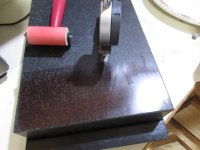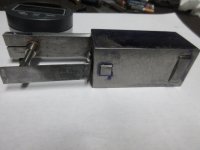rhb
Aluminum
- Joined
- Apr 27, 2019
- Location
- A small town in central Arkansas
I have been making a repeat-o-meter for checking surface plates using an ebay $31 Chinese electronic half tenth/1 um gauge.
It seems to work properly so I decided to try measuring the thickness of my typical application of Canode using a Speedball soft rubber printer's brayer.
Repeated measurements consistently showed a thickness of about a tenth which is actually not a lot more than the repeatability for the indicator.
Have Fun!
Reg
It seems to work properly so I decided to try measuring the thickness of my typical application of Canode using a Speedball soft rubber printer's brayer.
Repeated measurements consistently showed a thickness of about a tenth which is actually not a lot more than the repeatability for the indicator.
Have Fun!
Reg




